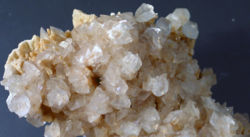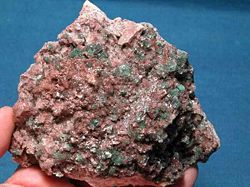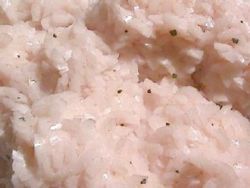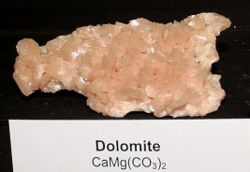Dolomite

 |
| Dolomite. |
 |
| Dolomite from Morocco |
 |
| Dolomite (General) |
 |
| Pale pink crystals of dolomite with a slight pearly luster. |
|
| |
Dolomite is the name of a sedimentary carbonate rock and a mineral, both composed of
calcium magnesium carbonate CaMg(CO3)2 found in crystals.
Dolomite rock (also dolostone) is composed predominantly of the mineral dolomite.
Limestone that is partially replaced by dolomite is referred to as dolomitic limestone. Dolomite was first described in
1791 as the rock by the French naturalist and geologist, Déodat Gratet de Dolomieu (1750-1801)
for exposures in the Dolomite Alps of northern Italy.
Properties
The mineral dolomite crystallizes in the trigonal - rhombohedral system. It forms white, gray to pink,
commonly curved crystals, although it is usually massive. It has physical properties similar to those
of the mineral calcite, but does not rapidly dissolve or effervesce (fizz) in dilute hydrochloric acid
unless it is scratched or in powdered form. The Mohs hardness is 3.5 to 4 and the specific gravity
is 2.85. Refractive index values are nω = 1.679 - 1.681 and nε = 1.500. Crystal twinning is common.
A solid solution series exists between dolomite and iron rich ankerite. Small amounts of iron in
the structure give the crystals a yellow to brown tint. Manganese substitutes in the structure also
up to about three percent MnO. A high manganese content gives the crystals a rosy pink color noted
in the image above. A series with the manganese rich kutnohorite may exist. Lead and zinc also
substitute in the structure for magnesium.
Formation
Vast deposits are present in the geological record, but the mineral is relatively rare in modern
environments. However, laboratory synthesis of stoichiometric dolomite has been carried out
only at temperatures of greater than 100 degrees Celsius, conditions typical of burial in
sedimentary basins - even though much dolomite in the rock record appears to have formed in
low-temperature conditions. The high temperature is likely to speed up the movement of
calcium and magnesium ions so that they can find their places in the ordered structure
within a reasonable amount of time. This suggests that the lack of dolomite that is being
formed today is likely due to kinematic factors.
Modern dolomite does occur as a precipitating mineral in specialized environments on the
surface of the earth today. In the 1950s and 60s, dolomite was found to be forming in highly
saline lakes in the Coorong region of South Australia. Dolomite crystals also occur in deep-sea
sediments, where organic matter content is high. This dolomite is termed "organogenic" dolomite.
Recent research has found modern dolomite formation under anaerobic conditions in supersaturated
saline lagoons along the Rio de Janeiro coast of Brazil, namely, Lagoa Vermelha and Brejo do
Espinho. One interesting reported case was the formation of dolomite in the kidneys of a
dalmatian dog. This was believed to be due to chemical processes triggered by bacteria.
Dolomite has been speculated to develop under these conditions with the help of sulfate-reducing
bacteria. This joins other research in pointing out many new interesting links between large-scale
geology and small-scale microbiology.
Dolomite appears to form in many different types of environment and can have varying structural,
textural and chemical characteristics. Some researchers have stated "there are dolomites and
dolomites" meaning that there may not be one single mechanism by which dolomite can form. Much
modern dolomite differs significantly from the bulk of the dolomite found in the rock record,
leading researchers to speculate that environments where dolomite formed in the geologic past
differ significantly from those where it forms today.
Uses
Dolomite is used as an ornamental stone, a concrete aggregate and as a source of magnesium oxide.
It is an important petroleum reservoir rock, and serves as the host rock for large strata-bound
Mississippi Valley-Type (MVT) ore deposits of base metals such
as lead, zinc, and copper. Where calcite limestone is uncommon or too costly, dolomite is
sometime used in its place as a flux for the smelting of iron and steel.
In horticulture, dolomite and dolomitic limestone are added to soils and soilless potting mixes
to lower their acidity ("sweeten" them). Home and container gardening are common examples of this use.